Trello is a well-known Project Management tool that utilizes a visual Kanban board to organize tasks and workflows. However, for many teams, Trello ends up being a temporary solution. These Project Management Tools Like Trello are good options to migrate.
There are a few key limitations that often drive the need to migrate away from Trello to alternative Project Management Tools Like Trello software:
- Limited customization – Trello does not provide many options for customizing boards, cards, and workflows to match your specific processes and needs.
- Lack of reporting – Trello has no reporting features for gaining insights from project data through charts, graphs, and dashboards.
- Missing advanced features – Trello is lacking features like Gantt charts, resource management, time tracking, and approval processes that become essential for larger projects.
- Limited integrations – Trello’s integration options with other tools and systems your team may use are rather limited.
With these limitations in mind, this article aims to help by reviewing alternative Project Management Tools Like Trello software with more features, customization, and capabilities to scale with your complex needs. We’ll compare Trello to 6 popular options: Doitify, Asana, Basecamp, ClickUp, Monday.com, and Teamwork. Our goal is to help you find a long-term Project Management Tools Like Trello solution that will continue to improve your project visibility, efficiency and results.

Key Features Of Project Management Tools Like Trello To Lookup
Visual Kanban Board View
Project Management Tools Like Trello Should have Kanban-style board view makes tasks and workflows highly visual. Users can drag and drop tasks between columns representing different stages and prioritize work at a glance.
Multiple Lists
Trello allows users to create multiple lists on a board for organizing tasks. Project Management Tools Like Trello provides standard lists like To Do, Doing, and Done but users can customize as many lists as needed for granular workflow tracking.
Task Assignment
With Trello, team members can be assigned to individual tasks (cards) so it’s clear who is responsible for what. Task assignees then receive email and app notifications to keep them accountable and up-to-date.
Checklists
Checklists can be added to Trello Project Management Tools Like Trello cards, making it easy to break down large tasks into smaller action items and subtasks. Task owners can then check off items as they are completed.
Attachments
Files and media can be attached directly to Trello cards, providing essential resources and materials for tasks. This helps keep all relevant content in one centralized location.
Due Dates
Project Management Tools Like TrelloDue dates can be applied to individual tasks using Trello’s integrated calendar. This helps teams track deadlines and prioritize work to meet scheduled milestones.
We have been written about Project Management Tools Like Asana in another article.
Why Migrate From Trello?
When looking at alternatives to Trello, there are a few key limitations that drive many teams to consider migrating to more robust Project Management Tools Like Trello.
Limited Customization Options
Trello offer fairly limited options for customizing boards, cards, and workflows according to your team’s specific processes and needs. From adding custom fields and statuses to tailoring card types, Trello provides basic templates that cannot be significantly altered. This often leaves gaps in workflows and makes it challenging to model inherently complex processes within Trello’s confines. For teams with specialized customized requirements, the lack of flexibility can become a hindrance over time.
Lack Of Reporting
Perhaps the biggest drawback of Trello and reason to find project management tools like Trello is that it offers no true reporting capabilities. There are no options for generating essential reports like burn charts, resource allocation summaries, progress dashboards, and more. Without insight into project data through reporting features, it becomes difficult to track key performance indicators, identify issues, and make important decisions for optimization.
Lack Of Advanced Features
While Trello provides basic features for managing tasks, it lacks many of the advanced functionality that teams require for complex projects. Things like Gantt charts, resource management, time tracking, approval processes, and the ability to attach large documents are commonly absent. This limited feature set means that as projects grow in scale and complexity, Trello often cannot scale accordingly and teams must then look for Project Management Tools Like Trello software with a broader range of features.
We have been written about Free Project Management Tools in another article.
Best Project Management Tools Like Trello
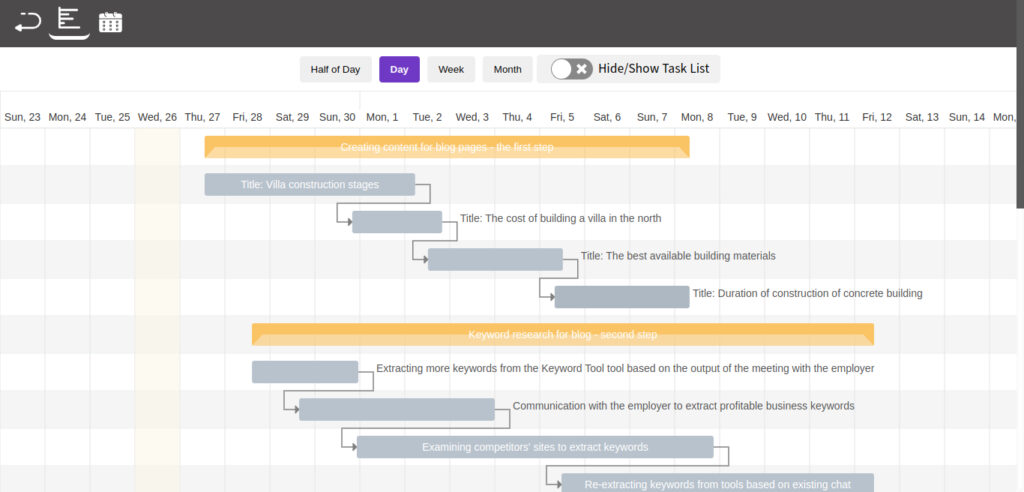
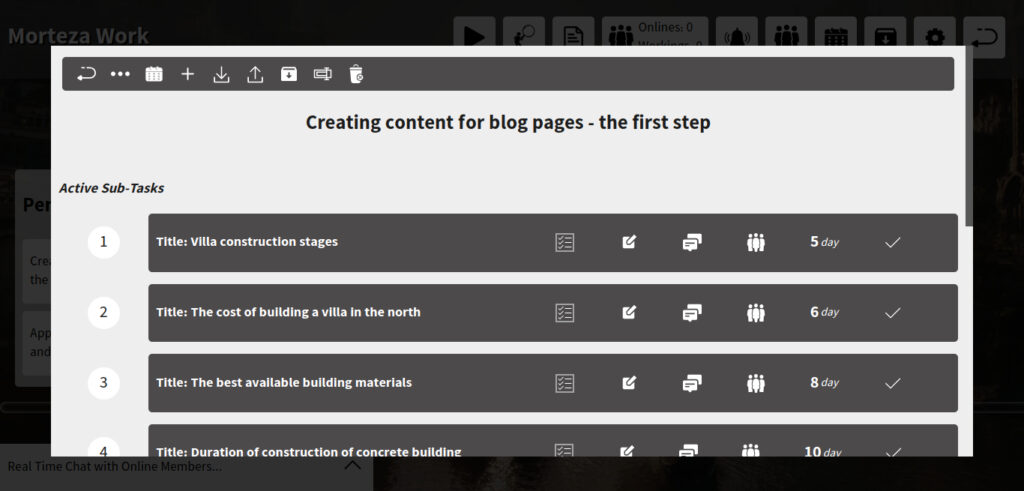
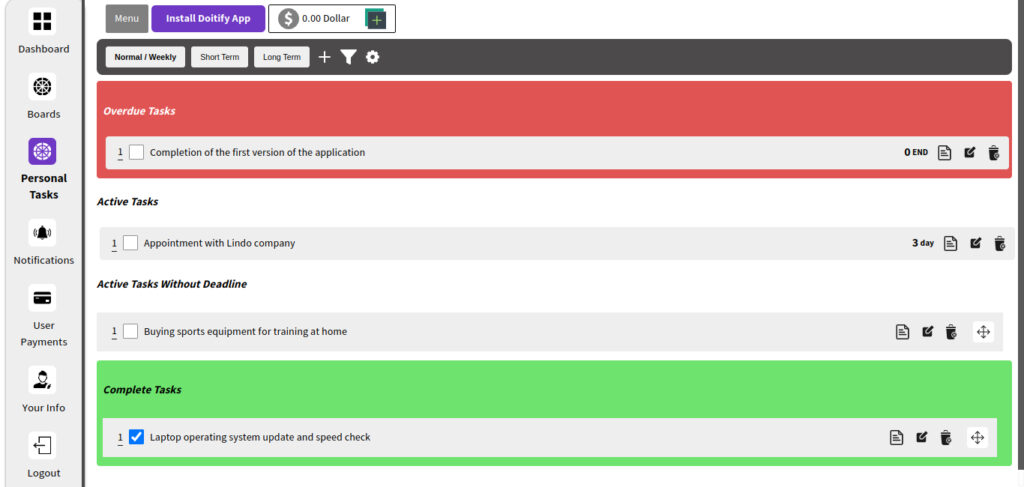

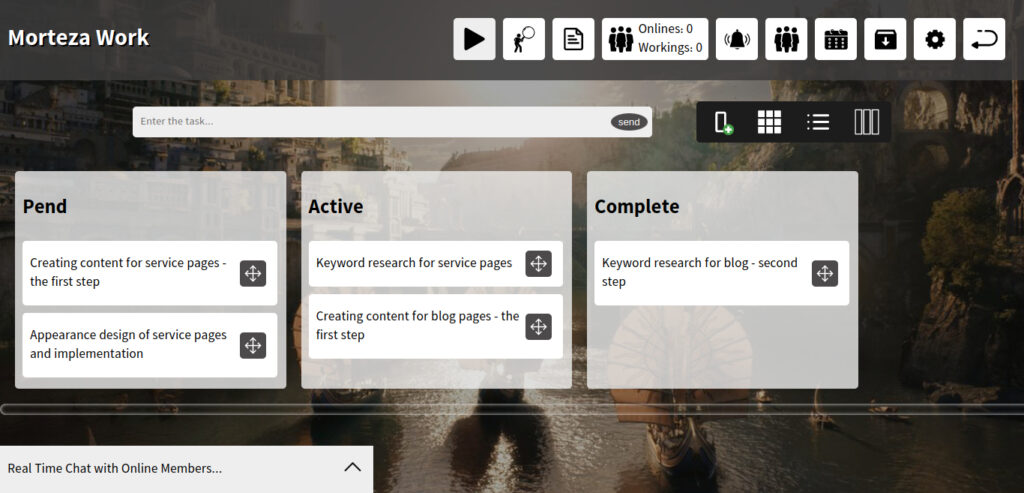
Doitify
Doitify is a project management tool that is designed to be more flexible and powerful than Trello. It has a wider range of features, including more flexible boards, more powerful automation, better reporting, and more integrations. Doitify also has better customer support than Trello.
Doitify boards are more flexible than Trello boards. You can create as many boards as you need, and you can customize them to your liking. You can also add different types of cards to your boards, such as tasks, checklists, and files.
Doitify has a more powerful automation engine than Trello. You can create complex automation rules to automate your tasks and workflows. This can save you a lot of time and effort.
Doitify has better reporting than Trello. You can generate reports on your projects, tasks, and boards. This can help you track your progress and identify areas where you need to improve.
Doitify has more integrations than Trello. You can connect Doitify with other apps, such as Google Drive, Dropbox, and Slack. This can help you to streamline your workflow and work more efficiently.
Overall, Doitify is a better alternative to Trello because it is more flexible, powerful, and has better reporting and integrations. If you are looking for a more advanced project management tool, Doitify is a great option.
Best For: Doitify is best for small to Large-sized businesses and remote teams. It is a cloud-based software that can be accessed from anywhere with an internet connection.
Platforms: as Web app for all platforms.
Doitify Pricing
- Free plan: The free plan includes all features, but is limited to 5 members and 5 MB of space.
- Premium plan: The premium plan costs $0.50 per month per member and includes unlimited space.
Doitify Features
- Global Quality: The ability to compete with the best foreign project management software.
- Free Plan: All features of the software are free, with the option to pay for additional storage and users.
- Remote Team Management: The ability to communicate and monitor the performance of remote employees.
- Different Management Systems: Support for Agile, Scrum, and other management systems.
- Online Time Tracking: The ability to track and save the online time of employees.
- Screen Sharing: The ability for admins to view the screens of working employees.
- Daily Work Reports: Daily reports of employee work for better team and project control.
- User Performance Tracking: The ability to track user performance in specific time periods.
- Advanced Subtasks: The ability to create advanced subtasks with start and end times.
- Quality Control: Consideration of quality control managers for subtasks.
- Dedicated Chat: Chat capabilities for each subtask.
- User Roles: The ability to assign roles and rules for users.
- Checklists: The ability to create checklists for each task and subtask.
- Subtask Status: The ability to set statuses for each subtask.
- Import/Export: The ability to import and export subtasks.
- Gantt Chart and Calendar: The inclusion of a Gantt chart and calendar in the free version.
- Language Support: Support for right-to-left languages such as Chinese.
- Regular Updates: Regular updates to add new features and improve functionality.
- Pricing: Fair prices and the ability to create a portal for dollar currencies.
We have been written about Project Management Tools Like Jira in another article.

Asana
While Asana retains a visual interface with boards, cards and checklists similar to Trello, it offers significantly more features for managing complex work.
Asana provides full customization capabilities that let teams tailor workflows, tasks and templates to their specific needs. The flexibility to model inherently complex processes sets Asana apart from Trello’s constrained options.
Asana features built-in reporting that generates charts, graphs and dashboards on key metrics. This provides valuable insights into project performance that are lacking in Trello which offers no reports.
The software includes capabilities like Gantt charts that help teams visualize timelines, dependencies and resource allocations for increased clarity into projects. These planning tools are absent in Trello.
Asana offers robust time tracking features that allow teams to track time spent on tasks, generate timesheets and optimize resource utilization. This level of insight into how time is spent is missing in Trello.
Additional capabilities like integrations, permissions, automation and approvals provide teams the controls they need to work efficiently in Asana beyond what Trello provides.
Best for: Medium to large teams who need a robust project management tool.
Platforms: web, iOS, and Android.
Asana Pricing
- Free version available with limited features.
- Paid plans start at $10.99 per user per month.
Asana Features
- Project templates: Asana offers a variety of project templates that users can use to get started quickly. Templates are available for a variety of project types, such as product launches, marketing campaigns, and team onboarding.
- Custom fields: Asana allows users to create custom fields for tasks and projects. This can be useful for tracking specific information, such as project budgets, client information, or project status.
- Task dependencies: Asana allows users to create task dependencies, which means that one task cannot be completed until another task is finished. This can help ensure that tasks are completed in the correct order.
- Forms: Asana offers a feature called Forms, which allows users to create custom forms to collect information from team members or stakeholders. Forms can be used for a variety of purposes, such as collecting feedback or submitting project requests.
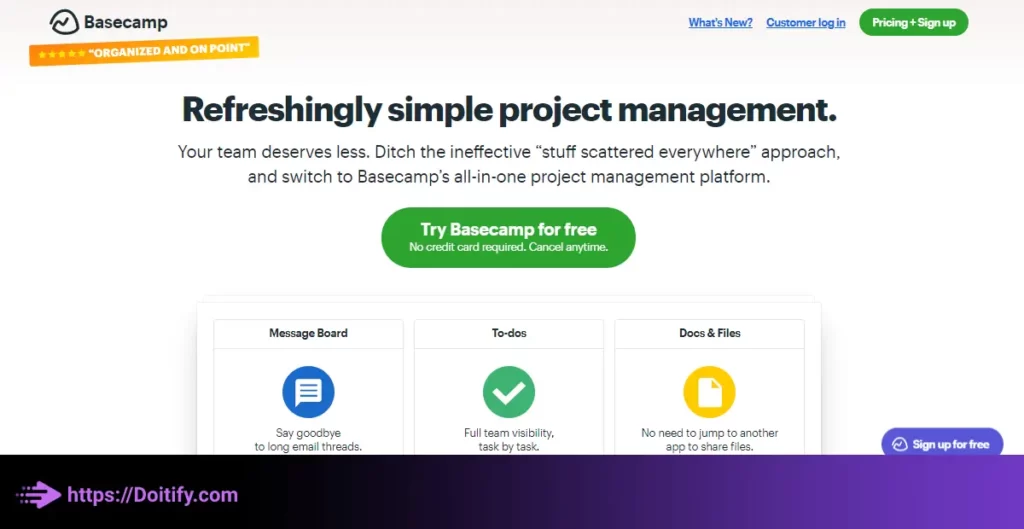
Basecamp
While Basecamp retains a clean and intuitive visual interface similar to Trello, it offers significantly more features for managing complex work at scale.
Basecamp provides full customization that allows teams to tailor workflows, to-do lists, schedules and roadmaps according to their specific needs. The ability to mold processes within Basecamp sets it apart from Trello’s constrained templates.
Basecamp offers built-in messaging that provides an efficient channel for real-time communication between team members. This streamlined discussion within projects keeps teams organized and on the same page.
The software features robust task management capabilities that go beyond Trello’s basic lists and cards. Tools like milestones, tags and in-depth checklists provide increased structure for managing complex work.
Basecamp provides analytics dashboards and reporting that give teams visibility into project progress. This insight into health and performance is missing in Trello which offers no reports.
Additional capabilities like file sharing, work scheduling, permissions and in-depth project planning tools optimize how teams work in Basecamp beyond what Trello provides.
Best for: small to medium-sized businesses and teams that need a simple and straightforward project management tool.
Platforms: Desktop, MacOS, Android, iOS
Basecamp Pricing
- Basic: 15 USD per month
- Pro Unlimited: 299 USD per month
Basecamp Features
- Simplicity and Ease of Use: Despite its advanced features, Basecamp is userfriendly and requires no specialized training.
- Security: Basecamp is designed to keep your information secure, using SSL and encryption technology to protect your data.
- Collaboration Capabilities: Basecamp makes it easy for team members to collaborate and coordinate using tools such as calendars, reminders, and shared files, helping teams stay in sync.
- Multimedia Capabilities: Basecamp allows teams to share multimedia files such as images, videos, and text documents.
- Project Tracking: With Basecamp, you can carefully track project progress and get detailed information about the project’s status.
- Easy Access: Team members can access Basecamp from anywhere and with any device, without the need to install or configure software.
- Reporting Capabilities: Basecamp enables easy preparation of project reports and graphical and numerical display of project progress.
- Task Automation: Basecamp provides the ability to create lists of repetitive tasks and perform them automatically, reducing project management time and costs.
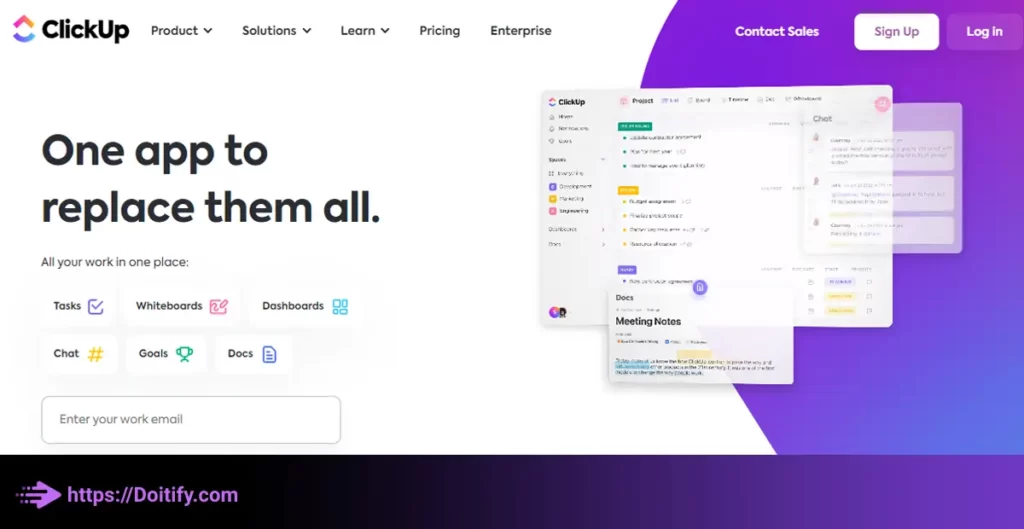
ClickUp
While ClickUp retains the visual simplicity of Trello’s boards, lists and cards interface, it offers significantly more features for managing complex work at scale.
ClickUp provides full customization that allows teams to tailor boards, tasks and workflows according to their specific needs. The ability to model inherently unique processes within ClickUp sets it apart from Trello’s limited templates.
ClickUp features integrated Gantt charts that help teams visualize project timelines, dependencies and resource allocations. This provides a more comprehensive view of projects that is missing in Trello.
The software offers robust time tracking capabilities that enable teams to track time spent on tasks, generate timesheets, and optimize resource utilization. This level of insight into how time is spent is lacking in Trello.
ClickUp also provides reporting features like dashboards, analytics and metrics that give teams visibility into key project performance indicators. This insight into progress and health is absent in Trello.
Additional features like fine-grained permissions for security, hundreds of integrations, templates for common project types, and tools for resourcing optimize how teams work in ClickUp.
Best for: Small to large teams who want a customizable project management tool with time tracking features.
Platforms: web, iOS, and Android.
ClickUp Pricing
- Free version available with limited features.
- Paid plans start at $5 per user per month.
ClickUp Features
- Customizable projects and tasks: You can create projects and tasks and assign them to team members.
- Time tracking: You can track the time spent on each task and see how much time is left before the deadline.
- Progress tracking: You can track the progress of each task and see how it fits into the overall project.
- Customizable workflows: You can create custom workflows that fit your specific needs.
- Integrations: ClickUp offers integrations with popular tools like Google Drive, Dropbox, and Slack.
- Time tracking: You can track the time spent on each task and see how much time is left before the deadline.
- Due dates: You can set due dates for each task and receive notifications when the deadline is approaching.
- Customizable reminders: You can set up custom reminders to keep you on track and ensure that you meet your deadlines.
- Time estimates: You can set time estimates for each task to help you stay on schedule.
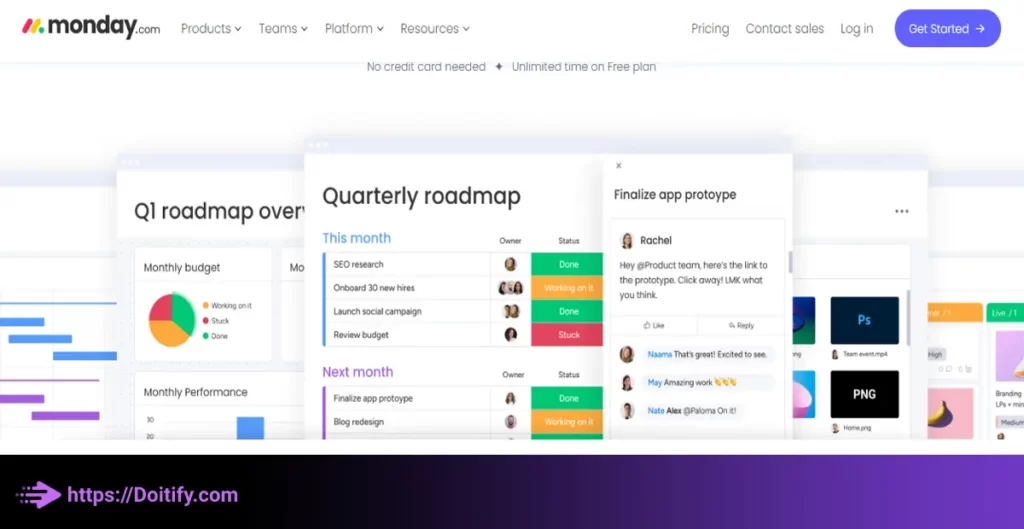
Monday.com
Though Monday.com maintains a simple visual interface like Trello, it offers significantly more features for managing complex projects at scale.
Monday.com provides a drag-and-drop Kanban board for organizing projects and workflows, along with lists, cards and checklists to represent and track tasks – just like Trello.
However, Monday.com offers full customization capabilities including the ability to create custom data models, card types, statuses and dashboards. This level of flexibility allows teams to tailor Monday.com exactly to their specific workflows and needs.
Monday.com also offers automation rules to automate routine tasks and workflows, a team planner to track progress, allocate resources and manage dependencies, a timeline view with Gantt charts, and robust analytics and reporting dashboards to measure key metrics.
Additional features include in-depth time tracking to boost team productivity, a vast marketplace with over 1,000 integrations with third-party apps, role-based permissions to control data access, and an offline mode so data remains accessible anytime.
Best for: Small to large teams who want a customizable project management tool with time tracking features.
Platforms: web, iOS, and Android.
Monday.com Pricing
- Free trial available for 14 days.
- Paid plans start at $8 per user per month.
Monday.com Features
- Customizable projects and tasks: You can create projects and tasks and assign them to team members.
- Time tracking: You can track the time spent on each task and see how much time is left before the deadline.
- Progress tracking: You can track the progress of each task and see how it fits into the overall project.
- Customizable workflows: You can create custom workflows that fit your specific needs.
- Integrations: Monday.com offers integrations with popular tools like Google Drive, Dropbox, and Slack.
- Time tracking: You can track the time spent on each task and see how much time is left before the deadline.
- Due dates: You can set due dates for each task and receive notifications when the deadline is approaching.
- Customizable reminders: You can set up custom reminders to keep you on track and ensure that you meet your deadlines.
- Time estimates: You can set time estimates for each task to help you stay on schedule.
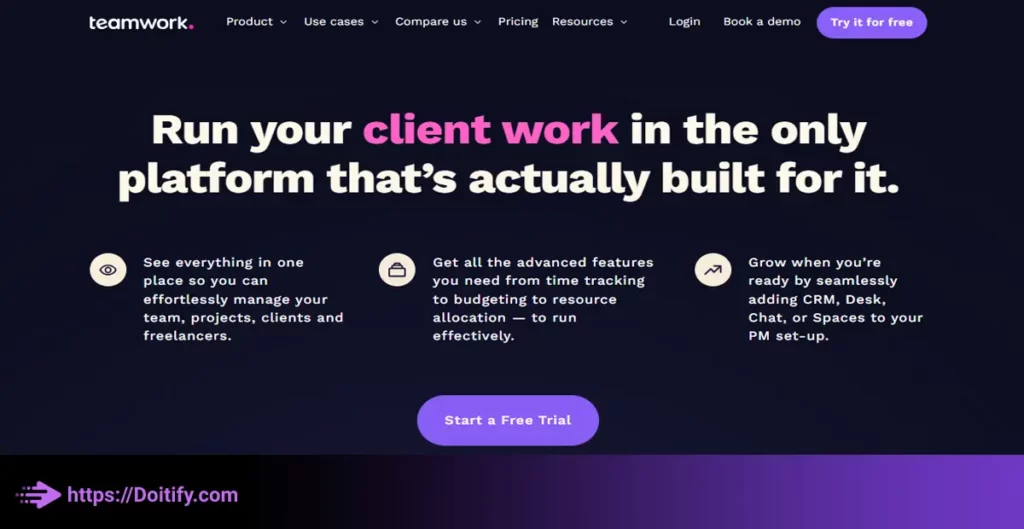
Teamwork
While Teamwork maintains a visually appealing card-based Kanban interface similar to Trello, it provides significantly more features for teams managing complex work.
Teamwork offers full customization so teams can tailor boards, cards and workflows to their specific needs. This level of flexibility allows Teamwork to accommodate inherently complex processes that may not fit within Trello’s confined templates.
Teamwork also features integrated Gantt charts to help teams visualize project timelines, dependencies and resource allocations. This provides a more holistic view of projects than Trello which lacks Gantt capabilities.
The software provides advanced resource management capabilities to efficiently assign tasks, track team member availability and optimize resource utilization. This level of detail into who is doing what work is missing in Trello.
Teamwork offers robust time tracking features that allow teams to generate timesheets, track time spent on projects, and bill clients accurately. The data can then be leveraged for workload balancing and optimizing resource allocation.
Additional features like automated workflows through triggers and rules, analytics and reporting, fine-grained access controls, and workload balancing insights make Teamwork a comprehensive project management solution beyond what Trello provides for growing and enterprise teams.
Best for: Accurate time tracking and billing clients
Platforms: Web app only
Teamwork Pricing
Start from $10 – $35/user/month
Teamwork Features
- Time tracking with multiple timers
- Invoice clients and track payments
- Customize workflows, fields and templates
- Discussions and file sharing
- Milestones and deadlines
- Task assignment and priorities
- Integration with Google Drive and Dropbox
We have been written about Simple Project Management Tool in another article.
Conclusion
While Trello has been an effective tool for basic task management and collaboration, it has limitations that make it unsuitable for larger and more complex projects. This often drives the need for teams to migrate to more robust software.
This article reviewed 6 promising alternatives to Trello: Doitify, Asana, Basecamp, ClickUp, Monday.com, and Teamwork. Each provides the visual simplicity teams love in Trello, while also offering significantly more features for customization, reporting, advanced planning and management of complex work at scale.
The best alternative for your team depends on key requirements like:
- Customization options to model your specific processes
- Insights and reporting needed to track progress and optimize performance
- Advanced capabilities for resource scheduling, time tracking and project planning
- Budget considerations
- Preferences around interface and ease of use
By carefully evaluating feature comparisons against your unique needs, you can identify which Trello alternative will give your growing team the right amount of control, visibility and efficiency to improve project results. Ultimately, migrating from Trello enables you to graduate from a basic task management tool into a true single workspace to organize, plan and execute all your teams’ complex work.
FAQs
What are the main limitations of Trello’s free plan?
The key limitations of Trello’s free plan are limited customization, lack of reporting, missing advanced features like Gantt charts and time tracking, and limited integrations.
How much does Trello cost?
Trello offers two paid plans:
Business Class: $9.99/user/month and provides features like file storage, invoicing, and LDAP directory.
Enterprise Plan: Pricing varies based on team size but provides the most features including single sign-on, auditing, and IT support.
What are some alternatives to Trello?
Some of the best Trello alternatives mentioned in this article include: Doitify, Asana, Basecamp, ClickUp, Monday.com, and Teamwork. Each offers robust functionality, customization, and capabilities to scale with growing project needs beyond what Trello provides.
Which alternative is best for my team?
There is no single “best” alternative. Each platform has its own strengths. The best alternative depends on your team’s specific needs, processes, budgets, and preferences. Carefully evaluating key requirements alongside feature comparisons can help identify the best Trello alternative for your team.


